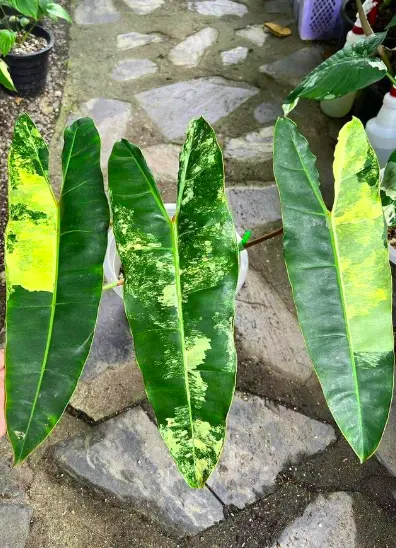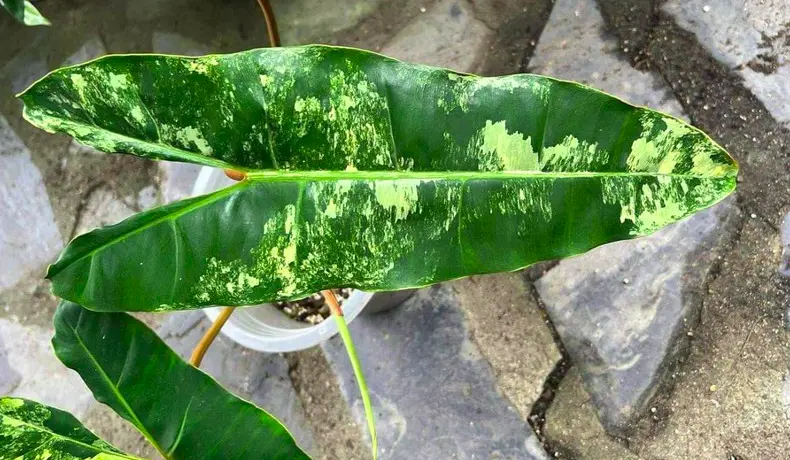Variegated billietiae is a unique plant species known for its vibrant and colorful leaves. Native to Central and South America, this flowering plant is characterized by its striking foliage with variegated yellow, white, and green leaves. Their attractive mottled leaves and vibrant colors make a great addition to any garden.
This guide will cover how to grow and care for variegated billietiae so you can enjoy its beauty for years to come. So, let’s get straight to it!
Finding variegated billietiae for sale might be difficult because of their rarity and high price. However, taking care of variegated billietiae plant species is relatively easy. They only need the right soil requirements, moisture levels, light source, and basic maintenance.
What is a Variegated Billietiae?

Variegated Billietiae, commonly known as Billietiae Variegata, is a beautiful and interesting plant native to tropical and subtropical climates. It is an evergreen shrub or small tree with yellow and green variegated leaves, white flowers, and small red fruits. Its unique foliage and colorful flowers make it an attractive addition to any garden.
The variegated billietiae can reach heights of up to 20 feet, with its branches spreading out in an umbrella-like fashion. Its oval-shaped leaves are arranged in opposite pairs along the branch and are 4-7 inches long and 2-4 inches wide. The leaf margin is finely serrated, and its color varies from yellow-green to grey-green. Its small white flowers have five petals and appear in late spring or early summer. The fruit is a small red berry about 1⁄2 inch in diameter.
Variegated billietiae requires little maintenance but does need regular pruning to maintain a manageable size and shape. This plant prefers well-drained soil, warm temperatures, and full sun to partial shade. During the winter months, ensure it is protected from frost and cold temperatures. Additionally, this plant may require occasional watering during periods of drought.
Where Do They Come From?
Variegated billietiae are a type of tropical plant native to Brazil and Peru. They are often referred to as The Jewel of the Amazon due to their strikingly beautiful foliage. The leaves are bright green, with white and yellow variegation throughout. These plants can grow up to 2 feet tall, with glossy green and dark maroon stems.
These plants thrive in warm and humid environments with high light exposure. They should be grown in a soil mix that is rich in organic matter and contains good drainage. Water thoroughly, but let the top layer of soil dry out between watering. Fertilize regularly with an all-purpose fertilizer or a specialized fertilizer for variegated plants.
To encourage bushy growth, prune back the stems in early spring. Remove any dead or diseased leaves, and cut off any growth crowding other stems. It’s also important to remove any yellowed leaves, as this could indicate root rot. Furthermore, variegated billietiae are a great addition to any indoor or outdoor garden, as they bring beauty and texture to the space.
Description and Appearance
Flowers
Each mature variegated billietiae axil comprises 1-3 inflorescences that bear flowers and a modified leaf bract. The flower stem is medium yellowish-green, with purple to green lineation. It’s also ribbed and a little flat on one side. The leaf bract is bright orange to dark green on the outside but lighter towards the apex. At anthesis, the interior of the leaf bract is greenish-white on the blade with somewhat darker borders, while the tube is crimson to purple.
Stems
The stems of variegated billietiae are light brown to yellow-brown, with apparent leaf scars and weakly unstable fractures. Internodes are wider than long, and nodes have fewer sturdy roods with a foliated surface. These aroids have cataphylls that fall quickly from green to light orange, sometimes brown or orange at the root.
Leaves

The pendant dark green leaves of variegated billietiae cluster at the apex of the stem. They feature a sturdy, long, widely spreading brilliant orange petiole that might be greenish-yellow, golden-yellow, olive green, or mild yellowish-orange in color. Mature variegated billietiae has elongated arrow-shaped dark green leaves that are relatively leathery and have a pale underside. These massive leaves are 2.4-4 times longer than broad and have a somewhat undulating, translucent, or reddish margin.
Growth rate
Variegated billietiae is a fast-growing aroid that can reach 12 feet or more in its native environment. However, at home, it will be smaller, 4-6 feet tall, and you will need to provide a climbing platform.
Growing habits of Variegated Billietiae
Variegated billietiae is an evergreen climbing hemi-epiphyte that grows on the ground before climbing to a tree or starts from a tree but grows roots that reach the ground. Its native range includes Brazil, Peru, and French Guiana, and it thrives in tropical rainforests at heights of 300-1300 feet above sea level in these habitats.
You can see these plants climbing rocks or tree stumps while young plants climb on fallen tree trunks. Finally, variegated billietiae prefer open, brighter areas with less dappled light, such as river sides, rather than dark-shaded environments.
How to Grow Them
Variegated billietiae can be propagated easily from stem cuttings or air layering. Here’s how to do it:
Stem Cuttings
- Use sterilized pruning shears to make a few 4-6 inch cuttings on the stem and remove the lower leaves.
- The next step is to cure the stem cutting. Dip the cuttings into rooting hormone and then place them into moist soil.
- Get the soil and plant pot (one with drainage holes) ready. It would be best if you also got a pole since the variegated billietiae is a renowned climber.
- Plant the stem in the soil but wait to install the mossy pole since it takes some time for the billietiae plant to sprout. You can do this by sticking your finger into the soil to make a hole before sticking the cutting and packing soil around it.
- Keep the soil slightly moist, and they should root in four to six weeks.
- Once your plant grows, you can begin wrapping it around the mossy pole.
Air Layering
- First, you must ”wound” your billietiae plant using a sterilized knife for the air layering method. Before making a cut approximately 2 inches long and 2 inches deep, sterilize the knife with isopropyl alcohol.
- For the wound to root, it must remain open. Stick a toothpick into the top and bottom of the incision to keep it open. Make sure it’s positioned in such a way that it keeps the wound open.
- Prepare some peat moss and sphagnum moss. The peat moss must be moist for it to stick to the wound.
- Spread the peat moss over the wound of the plant and cover it. To accelerate the growth of the roots, you can apply a rooting hormone.
- Wrap the plastic wrap over the stem and wound. Make sure the plastic wrap is firm enough to keep the peat moss in place but flexible enough to allow the peat moss to breathe.
- Prepare the plant pot (with drainage holes) and soil (well-draining).
- When the roots are approximately 3 inches long, they are ready to be planted. Before you plant it, you’ll need to cut a few inches above the wound and below the peat moss.
- Before planting the roots, remove the plastic wrap covering the wound and the peat moss before submerging the roots entirely in the soil.
It will take some time for your variegated billietiae to mature, but it will be worthwhile. To encourage growth, treat the plant as if it were a mature plant, watering it as required and ensuring that it receives bright indirect sunlight.
How to Care for Variegated Billietiae
When cared for properly, this plant can thrive in almost any environment. Here are some tips on how to care for variegated billietiae:
- Location – Variegated billietiae prefers indirect sunlight. Place it in a spot where it receives at least 4 hours of filtered sunlight daily. Avoid the direct, harsh sun, as it can scorch the leaves.
- Watering – Water your variegated billietiae when the top inch of soil feels dry. Overwatering isn’t recommended as it can lead to root rot. If you have hard water, consider using distilled or rainwater instead.
- Fertilizing – To keep your Variegated Billietiae looking its best, fertilize it every two to four weeks during the growing season with a diluted liquid fertilizer specifically formulated for tropical plants.
- Pruning – Prune your Variegated billietiae regularly to maintain their shape and encourage growth. Cut back dead or damaged branches and use sharp scissors to trim any overgrown stems or leaves.
- Temperature – Variegated billietiae loves warmth and humidity. Keep the temperature between 65°F and 80°F during the day and around 55°F at night. The plant could suffer from cold damage if the temperature drops too low.
With proper care and attention, your variegated billietiae will thrive and bring years of joy to your home.
Pests and Diseases
When growing variegated Billietiae, it is important to know the potential pests and diseases that can affect your plants. These plants are susceptible to common houseplant pests such as mealybugs, spider mites, and aphids. It is crucial to monitor your plants closely and inspect them regularly for any signs of infestation.
If you find any pests on your plant, the best way to get rid of them is by using an insecticidal soap or horticultural oil spray. Make sure to thoroughly spray all affected areas and repeat treatments every few days until the infestation has been eradicated.
Keeping your variegated billietiae plants in an area with good air circulation is also important. Poor air circulation can lead to fungal diseases such as leaf spots or root rot. To avoid these issues, prune away dead leaves or branches and regularly water your plant without over-watering.
In summary, if you are looking for a low-maintenance houseplant that emanates a tropical atmosphere in your home, the variegated billietiae is one to consider. These violets are truly lovely, low-maintenance houseplants. They need very little sunlight, water once or twice a week, and to be kept in dirt-free soil (so add some extra peat moss now and then). Just note how big your pot is and water accordingly to ensure it stays happy.
